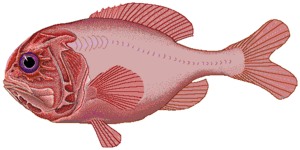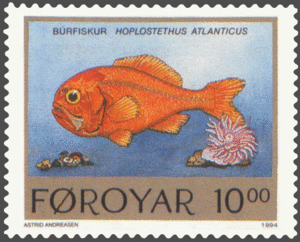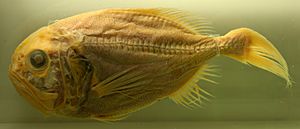Orange roughy facts for kids
Quick facts for kids Orange roughy |
|
|---|---|
 |
|
| Scientific classification |
The orange roughy (Hoplostethus atlanticus) is a large deep-sea fish. It is also called the red roughy, slimehead, or deep sea perch. This fish belongs to the slimehead family. The UK Marine Conservation Society says the orange roughy is "vulnerable to exploitation." This means it is at risk of being overfished.
Orange roughy live in cold, deep waters around the world. You can find them in the Western Pacific, eastern Atlantic, Indo-Pacific (near New Zealand and Australia), and off Chile. They live at depths from about 180 to 1800 meters (590 to 5,900 feet). These fish are famous for living a very long time, often over 200 years! They are important for deep-sea trawl fisheries. The fish are a bright brick-red color when alive. After they die, their color fades to yellowish-orange.
Like other slimeheads, orange roughy grow slowly and start breeding late in life. This makes them very sensitive to overfishing. Many groups of these fish, especially near New Zealand and Australia, were heavily fished in the late 1970s. Their numbers dropped a lot in just 3 to 20 years. However, some groups have recovered. Fisheries managers now believe these populations can be fished in a way that is sustainable, though they are still smaller than before fishing started.
Contents
What Does the Orange Roughy Look Like?

Orange roughy, Hoplostethus atlanticus
Faroese stamp issued: 7 Feb 1994
Artist: Astrid Andreasen
The orange roughy is not a thin fish. It has a rounded head with many canals that produce mucus. These canals are part of its lateral line system, which helps the fish sense movement in the water.
- It has one dorsal fin (on its back) with four to six spines and 15 to 19 soft rays.
- The anal fin (on its belly, near the tail) has three spines and 10 to 12 soft rays.
- It has 19 to 25 hard, bony plates called scutes on its belly.
- The pectoral fins (on its sides) have 15 to 18 soft rays each.
- The pelvic fins (on its underside) have one spine and six soft rays.
- Its caudal fin (tail fin) is forked.
The inside of its mouth and gills are bluish-black. Its mouth is large and slants upwards. The fish's scales are rough and stick to its body. It has a clear lateral line with 28 to 32 scales. Its eyes are large, which helps it see in the deep, dark ocean.
The orange roughy is the biggest known slimehead species. It can grow up to 75 centimeters (30 inches) long and weigh up to 7 kilograms (15 pounds). Most fish caught for sale are between 35 and 45 centimeters (14 and 18 inches) long.
Orange Roughy Life Cycle
Orange roughy are usually slow-moving fish that live near the seabed. They gather in groups, often around undersea canyons and seamounts. These areas have strong water currents, which bring lots of food.
These groups are not always for breeding or eating. Scientists think the fish go through active (feeding) and inactive (resting) phases. They gather in places with good water conditions for each phase. When they are inactive, they lose most of their color and are very calm.
- Predators: Large, deep-sea sharks, cutthroat eels, and snake mackerels hunt orange roughy.
When they are active, young orange roughy mainly eat tiny ocean animals called zooplankton. These include small shrimp and krill. Adult orange roughy eat smaller fish, like Lanternfish, and squid. Squid can make up to 20% of their diet.
What orange roughy eat changes with how deep they live. This helps them avoid competing for food with each other. For example, young fish eat more crustaceans in deeper waters, while adults eat more fish. This helps them share the food available in the deep ocean. The inactive phase helps them save energy when food is scarce. Orange roughy can live for over 200 years!
Reproduction
Orange roughy are fish that live in open water and migrate long distances. Each year, they travel hundreds of kilometers between their breeding and feeding areas. They form large groups to spawn. During spawning, the fish release many large, round eggs and sperm into the water. The eggs are about 2.25 mm (0.09 inches) wide and float because they have an orange-red oil droplet.
The fertilized eggs and young fish (larvae) float in the water. They rise to about 200 meters (660 feet) to develop. As they grow, the young fish swim down to deeper waters. Orange roughy release their eggs and sperm at the same time. It takes about 10 to 20 days for the eggs to hatch.
Female orange roughy do not produce many eggs. Each female lays only about 22,000 eggs per kilogram of her body weight. This is less than 10% of what most other fish species produce. A female rarely lays more than 90,000 eggs in her whole life. Spawning can last up to three weeks and usually starts around June or July. Orange roughy grow very slowly and do not start breeding until they are at least 20 years old. By then, they are about 30 centimeters (12 inches) long.
Because they take so long to start breeding (23-40 years), their populations grow and recover very slowly.
Lifespan
When people started fishing for orange roughy in the 1970s, they thought the fish lived for only about 30 years. But since the 1990s, we know these fish live for an amazing amount of time. Early studies estimated they could live for 149 years. Scientists found this by checking tiny amounts of special elements in their ear bones (called otoliths). Counting the growth rings on their ear bones showed ages from 125 to 156 years.
One fish caught in 2015 was thought to be over 230 years old. Orange roughy caught near Tasmania have been aged at 250 years! The orange roughy is the longest-lived commercial fish species. It also does not breed every year. This is very important for how we protect them.
Eating Orange Roughy
The meat of the orange roughy is firm and has a mild taste. It is sold without skin and bones, either fresh or frozen. The fish was renamed "orange roughy" from "slimehead" in the late 1970s. This was part of a program to make less popular fish more appealing to buyers.
The United States used to eat the most orange roughy. But recently, China has started buying a lot more. In 2014, the US imported about 1,455 tonnes (3.2 million pounds) of orange roughy. In 2015, China imported at least 4,000 tonnes (8.8 million pounds).
Many large food stores now have rules about selling sustainable seafood. This means they work with groups like the Marine Stewardship Council to make sure the fish they sell are caught in a way that protects the ocean.
In 2010, Greenpeace International added orange roughy to its "red list" of seafood. This list includes fish from fisheries that are not sustainable. Some groups argue that it is hard to fish in deep waters without harming the environment. However, others believe deep-water fishing can be sustainable if catches are kept low.
Because orange roughy live so long, they can build up more mercury in their bodies. They have mercury levels between 0.30 and 0.86 ppm. The average for other edible fish is 0.086 ppm. In 1976, the FDA set the safe mercury limit for fish at 1 ppm. Eating orange roughy regularly might not be good for your health. Also, orange roughy are not a good source of healthy omega-3 fatty acids.
Orange Roughy Fisheries
Global fishing for orange roughy started in 1979. Catches grew quickly, reaching over 90,000 tonnes in the late 1980s. But these high catches quickly dropped as fish numbers went down. For many groups of fish, people did not understand enough about their biology. This led to overfishing. By the end of the 1990s, three of New Zealand's eight orange roughy fisheries had collapsed and were closed. Because orange roughy live long, mature late, and do not have many offspring, their populations recover slower than most other fish.
Some orange roughy live in international waters. This makes it harder to control how much is caught. Organizations like the South Pacific Regional Fisheries Management Organisation (SPRFMO) and the South Indian Ocean Fisheries Agreement manage these fish. They are working to collect better information and set limits on catches in the open ocean. For example, SPRFMO limited orange roughy catches from 2007.
Orange roughy are almost always caught using bottom trawling. This fishing method has been criticized by environmental groups because it can damage the ocean floor. This, along with high demand for the fish, has led to a lot of criticism from environmentalists and the media.
New Zealand Fisheries
New Zealand currently has the largest orange roughy fisheries in the world. In 2014, they caught over 8,500 tonnes. This was 95% of all orange roughy caught globally. In 2015, New Zealand earned about NZ$53 million (US$37 million) from exporting orange roughy.
New Zealand manages its fisheries using a Quota Management System (QMS). Under this system, companies own shares of how much fish can be caught. For each type of fish, a Total Allowable Catch (TAC) is set. This TAC aims to keep the fish population at a healthy level or help it grow to that level. Orange roughy has been managed under this system since 1986.
The Ministry for Primary Industries in New Zealand is in charge of the QMS.
History of New Zealand Fisheries
Fishing for orange roughy in New Zealand began in the mid-1970s. At first, there were no rules, and many fish were caught. Fisheries management often allows a period where fish numbers are reduced to a level that can provide the most sustainable catch. For example, if a fish population starts at 100,000 tonnes, it might be fished down to 40,000 tonnes over several years. After that, catches are controlled more strictly to keep the population around 40,000 tonnes.
For New Zealand's orange roughy fisheries, the early estimates of fish numbers were wrong. Catch limits were too high for about ten years. Also, it was thought that more fish were caught than reported due to nets breaking or gear being lost. Catch limits were lowered in the mid-1990s. They were later increased, but it turned out the fish populations had not recovered. As a result, some fisheries were completely closed or had their catch limits reduced to just 1 tonne to allow the fish to rebuild.
In 2008, the Total Allowable Catch (TAC) for one New Zealand fishery was lowered. But this was challenged in court. The court ruled that the Minister of Fisheries did not have the legal power to set quotas for that specific area. This was because the law required a very exact estimate of the fish population. Because of this, the Fisheries Act was changed. Now, TACs can be set using the best available information, even if an exact estimate is not possible.
Current Situation (2016)
In 2009, the New Zealand fishing industry started an assessment of some orange roughy fisheries. They wanted to see if they could meet the standards of the Marine Stewardship Council (MSC). After this, the industry group Deepwater Group Ltd started plans to improve four orange roughy fisheries. These plans aim to help the fisheries meet MSC certification rules. These plans are public and are watched by the Sustainable Fisheries Partnership.
In 2014, new studies were done for four main orange roughy populations in New Zealand. One of these had been closed to fishing since 2000. These studies used new acoustic technology developed by the fishing industry. This technology helps scientists tell different types of fish apart and works in difficult areas. It also might allow scientists to see live video of what they are measuring. Other research, like better ways to tell the age of fish, was also important.
The 2014 studies showed that three of the fish populations had recovered enough to allow more fishing. So, the catch limits for these groups were increased. The fourth population was still low, so its catch limit was reduced by over 40% to help it rebuild.
The fishing industry also agreed to keep orange roughy populations within a healthy range (30–50% of their original numbers). They also agreed on a rule that sets catch limits based on the fish population's health. The current catch limits follow this rule.
In May 2014, three orange roughy fisheries began a full assessment to get certified by the Marine Stewardship Council.
Australian Fisheries
The Australian orange roughy fishery was found in the 1970s. By 2008, some fish populations were still healthy, but others had dropped to only 10% of their original size after years of fishing. It was the first commercial fish to be put on Australia's endangered species list because of overfishing. By late 2017, some Australian orange roughy fisheries had been reopened.
In July 2020, a group working for Australian orange roughy quota holders suggested that the eastern zone stock should get Marine Stewardship Council certification. They said the fishery and its management were very good. However, environmental groups like the Australian Marine Conservation Society and World Wildlife Fund objected. They said the report did not fully consider how bottom-trawling affects seamounts. The MSC's decision to allow these objections has raised questions about the independence of their standards. The certification decision is still being reviewed.
|
See also
 In Spanish: Reloj anaranjado para niños
In Spanish: Reloj anaranjado para niños


